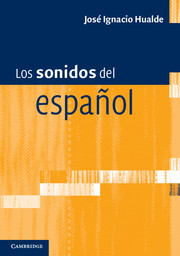Book contents
- Frontmatter
- Índice general
- Lista de figuras
- Lista de tablas
- Prefacio
- Lista de abreviaturas y convenciones
- El Alfabeto Fonético Internacional
- 1 Introducción
- 2 Consonantes y vocales
- 3 Caracterización acústica de las principales clases de sonidos del español
- 4 La sílaba
- 5 Principales procesos fonológicos
- 6 Vocales
- 7 Consonantes oclusivas
- 8 Fricativas y africadas
- 9 Nasales
- 10 Líquidas (laterales y vibrantes)
- 11 Principales alternancias morfofonológicas
- 12 El acento
- 13 Entonación
- 14 Variación en la pronunciación del español
- Apéndices
- Glosario de términos técnicos
- Bibliografía
- Índice alfabético
5 - Principales procesos fonológicos
Published online by Cambridge University Press: 05 June 2014
- Frontmatter
- Índice general
- Lista de figuras
- Lista de tablas
- Prefacio
- Lista de abreviaturas y convenciones
- El Alfabeto Fonético Internacional
- 1 Introducción
- 2 Consonantes y vocales
- 3 Caracterización acústica de las principales clases de sonidos del español
- 4 La sílaba
- 5 Principales procesos fonológicos
- 6 Vocales
- 7 Consonantes oclusivas
- 8 Fricativas y africadas
- 9 Nasales
- 10 Líquidas (laterales y vibrantes)
- 11 Principales alternancias morfofonológicas
- 12 El acento
- 13 Entonación
- 14 Variación en la pronunciación del español
- Apéndices
- Glosario de términos técnicos
- Bibliografía
- Índice alfabético
Summary
Introducción
En este capítulo definimos los principales tipos de procesos fonológicos, dando ejemplos tanto del español contemporáneo como de la evolución histórica de la lengua. Por proceso fonológico entendemos cualquier fenómeno que afecta a la realización de los fonemas en un contexto determinado de manera significativa. En el caso de los tipos más importantes de procesos fonológicos, como pueden ser la neutralización y la asimilación, consideraremos las soluciones analíticas que han sido propuestas por diversas escuelas fonológicas.
Neutralización de contrastes fonémicos
Hemos definido los fonemas como sonidos contrastivos en una lengua determinada. Hay, sin embargo, situaciones en que dos sonidos que en general se encuentran en oposición fonémica dejan de contrastar en un contexto específico. Para dar un ejemplo del inglés, está claro que en inglés /p/ y /b/ son fonemas diferentes y es fácil encontrar pares mínimos que prueban la existencia del contraste. El contraste se encuentra a principio de palabra (pit ‘hoyo, hueso (de fruta)’ vs. bit ‘un poco’), entre vocales (rapid ‘rápido’ vs. rabid ‘rabioso’) y a final de palabra (lap ‘regazo’ vs. lab ‘laboratorio’). Por otra parte, sin embargo, no hay tal contraste después de /s/ inicial de palabra. Existen palabras como spot ‘mancha, lugar’, speak ‘hablar’, spate ‘aluvión’, y muchas otras con estas secuencias iniciales, pero no **sbot, **sbeak, **sbate. Más aún, si existiera una palabra escrita sbot, se pronunciaría igual que spot. No hay posible contraste entre /p/ y /b/ en este contexto en inglés. Decimos que en inglés el contraste entre /p/ y /b/ se pierde o neutraliza después de /s/ inicial (y esto también se aplica a /t/ vs. /d/ y a /k/ vs. /ɡ/).
- Type
- Chapter
- Information
- Los sonidos del españolSpanish Language edition, pp. 93 - 112Publisher: Cambridge University PressPrint publication year: 2013



